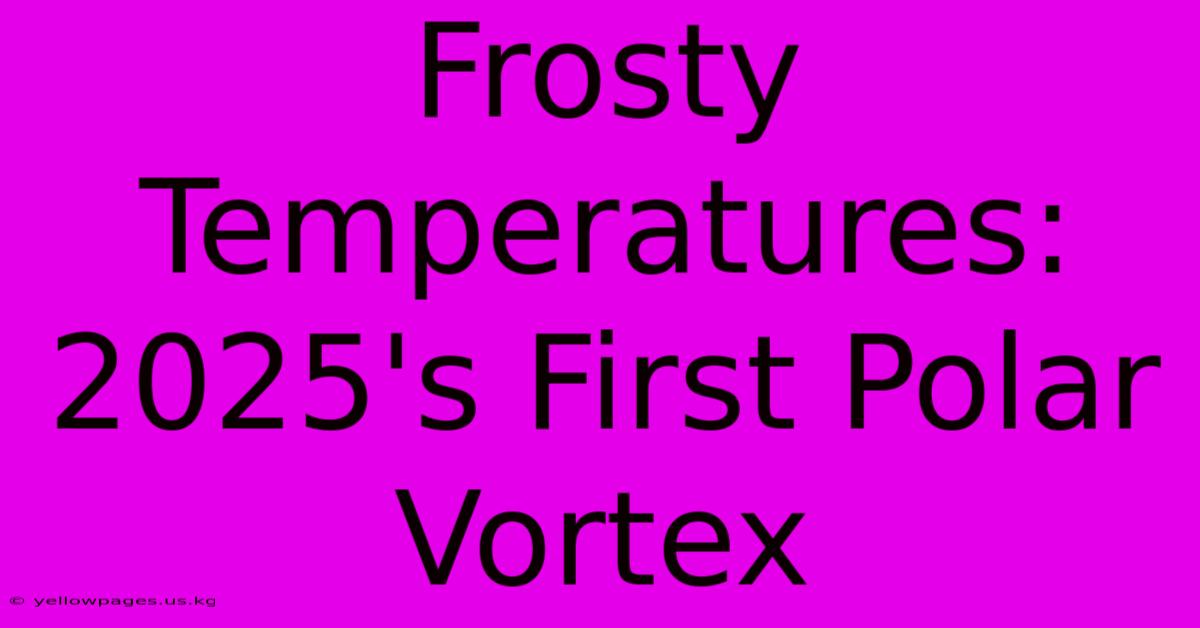Frosty Temperatures: 2025's First Polar Vortex

Discover more detailed and exciting information on our website. Click the link below to start your adventure: Visit Best Website trendingnews.us.kg. Don't miss out!
Table of Contents
Frosty Temperatures: 2025's First Polar Vortex
The year is barely underway, and already 2025 has thrown us a curveball – a surprise early arrival of the polar vortex. Millions across the Northern Hemisphere are bracing themselves against record-breaking low temperatures, icy conditions, and the disruption to daily life that comes with such extreme weather. This deep freeze isn't just a fleeting cold snap; experts are warning us to prepare for a prolonged period of frigid conditions.
Understanding the Polar Vortex: More Than Just a Cold Snap
The polar vortex isn't a new phenomenon. It's a large area of low pressure and cold air that sits over the North Pole. Normally, it's contained, but disturbances in the jet stream can cause it to weaken and split, sending frigid air southward. This year's early and intense incursion is raising concerns among meteorologists and prompting renewed interest in understanding these complex weather patterns.
What Makes 2025's Vortex Different?
Several factors contribute to the severity of this year's polar vortex:
-
Unusually Strong Jet Stream Disturbances: Scientists are observing stronger than usual disruptions in the jet stream, a fast-flowing, narrow air current high in the atmosphere. This instability is acting as a conduit, pushing the frigid Arctic air far south of its typical range.
-
Climate Change's Role: While the exact relationship is still being studied, some researchers believe climate change may be playing a role in increasing the frequency and intensity of these polar vortex events. The warming Arctic is disrupting the temperature gradient that normally keeps the polar vortex stable.
-
Sudden Stratospheric Warming (SSW): A significant SSW event in the stratosphere earlier this year weakened the polar vortex, making it more susceptible to these southward excursions.
The Impact of the Frosty Temperatures
The consequences of this prolonged polar vortex are far-reaching and impacting various sectors:
-
Energy Shortages: Increased energy demand for heating is straining power grids, potentially leading to rolling blackouts and disruptions in essential services.
-
Travel Disruptions: Significant snowfall and icy conditions are causing widespread travel chaos, with flight cancellations, road closures, and disruptions to public transport.
-
Economic Impact: Businesses are facing reduced productivity due to employee absences and supply chain disruptions. The agricultural sector is particularly vulnerable, with potential damage to crops and livestock.
-
Public Health Concerns: Exposure to extremely low temperatures increases the risk of hypothermia, frostbite, and other cold-related illnesses. Vulnerable populations, such as the elderly and those with pre-existing health conditions, are particularly at risk.
Preparing for the Frosty Future: Mitigation Strategies
While we can't control the weather, we can prepare for it. Here are some crucial steps to take:
-
Stay Informed: Monitor weather reports regularly and heed all official warnings and advisories.
-
Insulate Your Home: Ensure your home is adequately insulated to retain heat and reduce energy consumption.
-
Protect Yourself from the Cold: Dress in layers, cover exposed skin, and limit time spent outdoors.
-
Check on Vulnerable Neighbors: Make sure elderly neighbors and those living alone have adequate supplies and support.
-
Prepare an Emergency Kit: Assemble a kit with essential supplies, including water, non-perishable food, medications, blankets, and flashlights.
The Long-Term Outlook: Research and Adaptation
This early and intense polar vortex serves as a stark reminder of the unpredictable nature of extreme weather events. Further research is crucial to understanding the complex interplay of factors contributing to these events, and how climate change might be influencing them. Preparing for a future with more frequent and intense extreme weather necessitates not only immediate mitigation strategies but also long-term adaptation plans. The 2025 polar vortex is a wake-up call; we need to be better prepared for what the future may hold.
Keywords: Polar vortex 2025, extreme cold, record low temperatures, winter weather, climate change, jet stream, sudden stratospheric warming, SSW, energy shortages, travel disruptions, public health, cold weather safety, winter preparedness, extreme weather events, adaptation strategies, mitigation strategies.

Thank you for visiting our website wich cover about Frosty Temperatures: 2025's First Polar Vortex. We hope the information provided has been useful to you. Feel free to contact us if you have any questions or need further assistance. See you next time and dont miss to bookmark.
Featured Posts
-
Dallas Store Hours New Years Eve 2024
Jan 01, 2025
-
Uof L Defeats Washington Sun Bowl Victory
Jan 01, 2025
-
Pat Ferschweiler Extends Contract
Jan 01, 2025
-
Brooklyn Subway Fire Killing Nypd Ids Victim
Jan 01, 2025
-
Bowl Game Schedule Watch College Football Today
Jan 01, 2025
